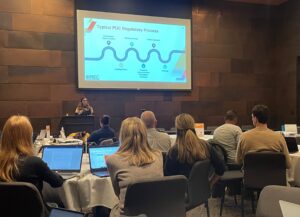Distribution! Interconnection! IREC brings electricity (and metal) to summit workshop


(IREC’s Radina Valova talks through a typical public utility commission’s regulatory process. Valova was among the presenters in a day-long interconnection workshop on Wednesday, November 15, 2023.)
Training provides useful skills to beginners and experts alike
(Minneapolis, MN) – The Interstate Renewable Energy Council hosted a full-day Interconnection Training on the eve of its Vision Summit 2023. Its curriculum included reading interconnection tariffs, evaluating interconnection applications, and a thoughtful conversation about equity in the energy transition. The subject matter was broad enough for newcomers to digest, yet occasionally so granular that only steely-eyed engineers could keep up.
About three dozen people filled the Thomas Swain Room of the McNamara Alumni Center on the University of Minnesota’s campus, eager to learn about interconnection. But first- a song about it. I’m not kidding. Listen for yourself:
Oh distribution, interconnection
A topic that might seem like a bore
But when you dive into the details
You find it so much more
That was Brian Lydic, IREC’s chief regulatory engineer with a little AI-generated assistance. Or so he claims. I’m pretty sure that masterpiece was mostly Brian’s.
The first session of the day focused on reading interconnection tariffs, or the “rules of the road” for distributed energy resources (DERs) to safely and reliably integrate and interact with the grid. Sky Stanfield, who represents IREC on interconnection proceedings, walked the room through the interconnection process from prospecting to commissioning.
Radina Valova, Vice President of IREC’s Regulatory Program, highlighted the importance of streamlining an often slow and confusing set of protocols. “Not all stakeholders are equally resourced,” she explained, noting that many states don’t revisit their policies for years.
SAVE THE DATE! The next edition of the GridTECH Connect Forum will be held in Orlando, Florida on February 26, 2024. We’re bringing together developers, utilities, and regulators to take on the critical issue of DER interconnection in the Southeast. Register to secure your seat today.
Participants were instructed to look up Minnesota’s Distributed Energy Resources Interconnection Process and compare elements of it to IREC’s recommendations, including timelines and types of application forms. IREC’s team discussed the need for data transparency across the renewable energy industry, encouraging commissions to ask public utilities what things cost.
“Data- or lack thereof- has real consequences for interconnection customers and utilities,” said Valova.
Delays, often exacerbated by staffing and study issues, lead to subscribers losing trust and being unable to see themselves as a part of the energy transition. IREC encouraged frequent updating of hosting capacity maps, preferably monthly by utilities.

The workshop pivoted to understanding how interconnection applications are evaluated, but not before another rendition of everyone’s new earworm. Are you ready for the heavy metal version?
Honestly, I like that more. Sounds a bit like Slayer, and I didn’t get empathetically nervous and sweaty while listening to this one! Brian, you and your soul patch ROCK.
Lydic and fellow IREC engineer Midhat Mafazi began a 101-style introduction to electricity and the grid, touching on key equations and terms. They showed how DERs impact the grid and how utilities study and monitor those impacts. Mafazi introduced the tenets of AC power by associating them with components of a frosty beer mug; the last bit of refreshment before a slog through faults, screens, and regulatory standards.
At the end of their presentation, the duo emphasized the value of supplemental screens, which have saved some community solar projects from being scrapped. They also encouraged regulators to take a closer look at the usefulness and scope of some screens, believing them to be overly conservative in modern systems.

IREC rounded out its workshop with an engaging discussion on clean energy justice and equality. Shay Banton, regulatory program engineer and energy justice policy advocate for IREC, introduced the three main types of interconnection inequities: technical complexity, grid constraints, and financial burden.
Banton warned that procedural complexities and difficult-to-find technical requirements can create resubmittal loops that ultimately doom projects in Low to Middle Income (LMI) communities. “And the later you interconnect, the more likely you’ll trigger an upgrade or press up against grid constraints, making your project non-feasible,” they explained.
Subscribe today to the all-new Factor This! podcast from Renewable Energy World. This podcast is designed specifically for the solar industry and is available wherever you get your podcasts.
The room broke into groups to discuss the pros and cons of solutions to interconnection inequities, including assistance with project siting, application guidance, and financial assistance. Banton led a discussion of alternatives like cost-sharing options and new cost mechanisms, identifying the importance of equity-centered distribution planning and having community leaders at the table.
Banton says IREC is expecting to publish its own technical report on interconnection equity next year and is working alongside Vote Solar to draft a toolkit.
Ultimately, IREC’s workshop provided its attendees with useful takeaways regardless of experience level. As Lydic put it in his soon-to-be smash hit: “(Interconnection) might not seem like much, but it’s something we all need.”




